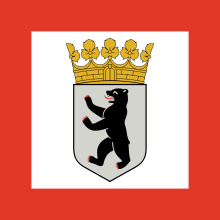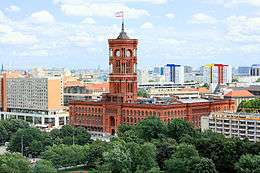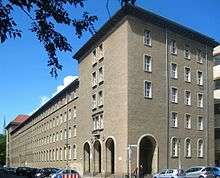Senate of Berlin

The Senate of Berlin is the executive body governing the city of Berlin, which at the same time is a state of Germany. According to the Constitution of Berlin the Senate consists of the Governing Mayor of Berlin and up to eight Senators appointed by the Governing Mayor, two of whom are appointed (Deputy) Mayors.[1] The Senate meets weekly at the Rotes Rathaus (Red Town Hall).[2]
History
The Brandenburg municipalities of Alt-Berlin and Cölln had received town privileges in the 13th century and from 1307 on shared a common administration, but were divided after the elector subjected the city (following the idea of divide and rule) and made it his residential city in 1448. King Frederick I of Prussia by resolution finally had both towns, and three later founded adjacent cities,[3] merged and elevated to the "Royal Capital and Residence City of Berlin" as of 1 January 1710.

From the Prussian reforms of 1808 until 1933, Berlin (expanded to Greater Berlin in 1920) was governed by a Magistrat (compulsorily dissolved by Nazi act on 15 March 1933), which was the executive committee of the Stadtverordnetenversammlung (city council; last convened on 27 June 1933)[4] and was represented in each of the boroughs of Berlin by a local office (usually housed in the town hall of a formerly independent suburb).[5] The council was headed by a Lord Mayor, or Oberbürgermeister. Lord Mayor Heinrich Sahm, elected in 1931, remained in office, and joined the NSDAP in November 1933, but resigned in 1935. His power totally depended on Julius Lippert, on 25 March 1933 appointed as Prussian State Commissioner for Berlin. So Berlin was de facto under the ultimate governance of the Nazi regime.
After the defeat of Nazi Germany, Berlin was to be under the ultimate governance of the Allied Kommandatura. However, in the election of 20 October 1946, the city elected an SPD-majority Stadtverordnetenversammlung and an SPD mayor (Otto Ostrowski, resigned 1947). The second elected SPD mayor, the devoted anti-communist Ernst Reuter, was vetoed by the Soviet commander, so Louise Schroeder (SPD) officiated as only acting lord mayor. The Western allies permitted the Berlin SPD to hold a referendum on whether to merge with the Communist party to form a unified single party of the left, the Socialist Unity Party, as realised under pressure in the Soviet occupation zone of Germany, and the members voted against the merger.[6]
_Neues_Stadthaus.jpg)
This was unacceptable to the Soviets, who engineered the establishment of an alternative city council in the sector under their direct control.[7] Following the Berlin Blockade, the Soviet sector, which became known as East Berlin (and the capital of the German Democratic Republic as of 1949) and the three western sectors (British, French, and U.S.) were functionally separated following the Communist putsch in Berlin's city government in September 1948 (a situation formalised in the Four Power Agreement on Berlin of 1971).
Under the new constitution of West Berlin which came into force on 1 September 1950, Berlin was defined as a state of the Federal Republic of Germany; however, due to the Allied veto, its representatives in the federal parliament (and later in the European parliament) were not directly elected by the citizenry, but appointed by the Berlin parliament (Abgeordnetenhaus) and had no voting power, but a merely advisory vote in those parliaments.[8] On the model of the two Hanseatic city-states within the Federal Republic, Hamburg and Bremen,[9] the Berlin Senate, chosen by the parties represented in the Berlin parliament, was established to perform the functions of a state government,[10] with each of its members heading a department, equivalent to a state ministry, and a Regierender Bürgermeister (Governing or Executive Mayor) at its head and one Bürgermeister as his/her deputy. In the 1950 constitution the maximum number of senators was 16,[11][12] then each elected by the parliament, but the first Senate had 13.[13]

Thus, following the Hanseatic tradition, the lord mayor was only primus inter pares since he and all senators had an elective mandate, so the lord mayor could not dismiss any senator, but only the parliament could. Anyway, until 1990 the elected candidates gained any legal power as lord mayor and the senators only after their confirmation by the western Allied commanders of West Berlin. Since both the building then used as the town hall of Berlin, the Neues Stadthaus, and the Rotes Rathaus which had been destroyed and was not rebuilt until 1956, were in East Berlin, the Senate met at the former town hall of Schöneberg, Rathaus Schöneberg.[14]
During the transition to a reunified Germany in 1990, a new Magistrat was elected in East Berlin and the Senate appointed in West Berlin, and they ruled jointly as a Landesregierung aus Senat und Magistrat (state government of Senate and Magistrat, known popularly as the MagiSenat),[15][16] which initially met in alternate weeks at the Schöneberg town hall and the Red Town Hall.[17] The Oberbürgermeister (East) and the Regierender Bürgermeister (West) similarly headed the government jointly.
With the completion of reunification on 3 October 1990, the MagiSenat became a unified Berlin Senate, not depending on Allied confirmation anymore, and which was reduced to a maximum of 8 members and senators are now appointed by the Governing Mayor (1995 amendment of the constitution); also, there are now two Deputy Mayors instead of one.[1] The senate meets in the room in the Red Town Hall which was originally created for the Magistrat in the 1950s.[2]
Departments
Berlin is governed by a maximum of eight senators together with the head of state, the governing mayor.[18] Until December 2016 each senator presideded over one of the following departments:
- Senate Chancellery
The Senate Chancellery (German: Senatskanzlei) staff coordinates the Senate's policies and supports the governing mayor.
- Senate Department for Labour, Integration and Women's Affairs
(Senatsverwaltung für Arbeit, Integration und Frauen)
- Senate Department for Education, Youth and Science
(Senatsverwaltung für Bildung, Jugend und Wissenschaft)
- Senate Department for Finance
(Senatsverwaltung für Finanzen)
- Senate Department for Social Affairs and Health
(Senatsverwaltung für Gesundheit und Soziales)
- Senate Department for the Interior and Sports
(Senatsverwaltung für Inneres und Sport)
- Senate Department for Justice and Consumer Protection
(Senatsverwaltung für Justiz und Verbraucherschutz)
- Senate Department for Urban Development and the Environment
(Senatsverwaltung für Stadtentwicklung und Umwelt)
- Senate Department for Economic Affairs, Technology and Research
(Senatsverwaltung für Wirtschaft, Technologie und Forschung)
References
- 1 2 The Constitution of Berlin: Section IV: The Government, Berlin.de
- 1 2 Virtueller Rundgang: 7. Senatssitzungssaal, Berlin.de (in German)
- ↑ These were Friedrichswerder, Dorotheenstadt, and Friedrichstadt.
- ↑ T.H. Elkins with B. Hofmeister, Berlin: The Spatial Structure of a Divided City, London: Methuen, 1988, ISBN 0-416-92220-1, e-edition Taylor & Francis 2005, ISBN 0-203-98402-1, p. 11.
- ↑ Elkins, p. 23.
- ↑ Elkins, pp. 34–35.
- ↑ Elkins, p. 37.
- ↑ Elkins, p. 40.
- ↑ Europa World Year Book 2004 Volume 1, New York: Taylor & Francis, ISBN 1-85743-254-1, p. 1845.
- ↑ Jan Edmund Osmanczyk and Anthony Mango, Encyclopedia of the United Nations and International Agreements: A to F, New York: Taylor & Francis, 2002, ISBN 0-415-93920-8, p. 191.
- ↑ Elkins, pp. 41–42.
- ↑ Alexandra Richie, Faust's Metropolis: A History of Berlin, New York: Carroll & Graf, 1998, ISBN 0-7867-0510-8, p. 774.
- ↑ Ann Tusa, The Last Division: a History of Berlin, 1945–1989, Reading, Massachusetts: Addison Wesley, 1997, ISBN 0-201-14399-2, p. 35.
- ↑ Elkins, p. 169.
- ↑ Eckardt D. Stratenschulte, "Mission Accomplished? Berlin Society and the Challenge of Reunification (pdf) p. 12.
- ↑ Sigrid Kneist, "Berliner Wiedervereinigung: Am Anfang stand der Magi-Senat", Der Tagesspiegel 2 October 2010 (in German)
- ↑ Der "MagiSenat" unter Walter Momper und Tino Schwierzina, Berlin.de (in German)
- ↑ Die Beauftragte des Berliner Senats für Integration und Migration (June 2013). "Welcome to Berlin" (PDF). Die Beauftragte des Berliner Senats für Integration und Migration. p. 1. Retrieved 10 February 2014.
See also
External links
- Senate meeting room
- List of Senators since 1945
- Constitution of Berlin. Section IV. The Government.
- Procedural Rules of the Senate(in German)
- Senate Departments (in German)
